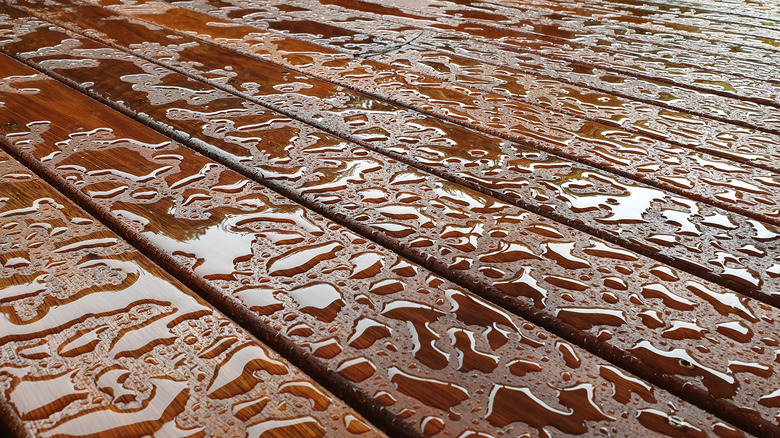Don't Make This Common Mistake When Staining Your Deck
Homeowners with decking know the value of a well-kept feature. The exterior deck is a constant source of entertainment. This works particularly well during the lazy summer days and the evenings of the fall when the nighttime chill begins to creep in. Decks provide a wealth of opportunity when it comes to expanding the ways in which you can utilize your home's overall footprint for comfort and relaxation.
But the deck should be stained and resealed on a regular basis. Seals Mart suggests resealing a deck every three years and Angi recommends staining the deck every two to three years. These timelines will vary depending on the amount of sunlight and foot traffic that the decking sees on a regular basis, but they stand in as a useful rule of thumb.
Staining the deck returns it to a level of aesthetic beauty that can't be matched in any other way. Restaining your deck makes it look like a new feature that's just been added, warding off the effects of time and use. Hardwood installations enjoy this unique sense of renewal, but caring for the deck and ensuring that you stain the surfaces with caution and consistency is crucial.
Many homeowners plan out the staining process as part of larger home maintenance tasks but fail to take into consideration the full scope of weather effects that can make for an ineffective stain application. Considering all the ways that weather can impact the job will help you perfect the task.
Summer heat can impact applied stain
Angi notes that direct sunlight and the heat that comes along with it can reduce the effectiveness of existing coats. Similarly, Bob Vila reports that restaining your deck in the middle of the day — when the sun is at its peak and the temperature is hottest — can lead to an evaporation of the liquid stain. This results in a lackluster finish to the project.
Making a day of the project is often the best approach, especially if you're tackling a stain renewal during the summer months when sunlight hours are at their maximum and the heat comes in constant waves. It's a good idea to start early in the morning to get down a first coat before the afternoon sun starts to bake the wooden decking and everything else in your yard. This will give you a few hours to allow the coat to dry, specifically before the sun is at its highest. Then, later in the day, you can return to the project area to apply a second coat that will dry as the sun begins to set, protecting both applications from the worst of the day's rays and intense heat.
Water and moisture erode effectiveness
In addition to the problems that heat and sunlight overexposure can bring to the table, moisture is equally problematic for a homeowner looking to restain their deck. On the other end of the spectrum from intense sunlight that dries out your stain, rainwater can eliminate the effectiveness of a new coat of stain altogether (via Angi), making it run off the wooden surface entirely. The little bit that will be left over will likely contain splash marks, too. This means you may need to start the whole process over again with the sanding phase rather than simply applying an additional coat of stain.
Paying attention to the weather forecast is a crucial step in getting this project done right and completed quickly enough to mitigate any environmental factors that could influence the outcome. Angi notes that restaining a deck should be done in the fall, if possible. This is because the fall weather is the most conducive to the needs of your wooden surface. Spring and summer months are often humid and hot, and the winter presents temperature drops that make staining less effective.
Angi also suggests considering adding a covering to any parts of the deck that are exposed. When reworking your decking every few years, it's worth considering add-ons that can make the space more effective and comfortable. A covering not only improves comfort, but it increases the lifespan of your stain by protecting it from rainwater and other elements.
Planning for the full job requires a few days on either end of the project
The most important thing that homeowners can do when approaching this task is to prepare. Multiple days are needed to ensure that the restaining task is done correctly and that the deck is put back into serviceable condition at the end of the project. Bob Vila notes that poor surface preparation is one of the main culprits involved in a bad stain job on residential decking. If you are restaining your deck in the summer months, you may be tempted to quickly rush through the preparation phase in order to put down a few coats of stain before the weather turns and rain returns to your community, but this simply won't produce the results you're looking for.
Finding a two- or three-day period in which there is little chance of rain — and ideally won't be too intensely sunny either — is the best approach when starting this project. Sanding down the surface the day, or evening, before getting to work on the stain itself is often a great way to make for a streamlined application of the stain itself. Of course, this means paying extra attention to the forecast to find a time that best suits the entire task, from start to finish. Including overage time is also important because it means you won't be up against the clock to finish off the second coat, hoping it dries in time.



